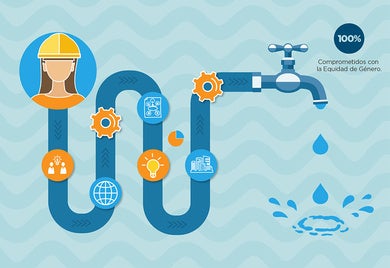
Untapped Potential: Water, Women and Public-Private Partnerships
More than half century ago, John F. Kennedy said: “Anyone who can solve the problems of water will be worthy of two Nobel prizes — one for peace and one for science.” Today, despite having a third of the world’s freshwater resources, Latin America and the Caribbean is home to 30 million people without access to clean drinking water, and 100 million without safe sanitation. The impressive urban growth in the region during recent years has only exacerbated this problem. Women provide a unique perspective for water management The water availability challenge is already evident in the region — particularly within the poor communities in cities. Women and girls are the most affected in these households, as they are usually in charge of ensuring water provision for their families. For this reason, women can play a key role in the implementation of innovative solutions that are in-tune with the needs and preferences of impoverished communities. This can have a positive impact not only in less favored urban areas, but also in the overall way in which the sector currently operates. There are already cases where women have taken the lead in the management of poor communities’ water systems, and the results have been encouraging. This user-centered approach acknowledges women’s vital role in water provision, and is helpful not only in refining project design and management, but can also increase consumers’ willingness to pay for the service. For utility providers, this can translate into multiple benefits, including improved cash flows, more resources for infrastructure investments, and service quality enhancements. [clickToTweet tweet="Women make up less than 17% of the water and sanitation labor force #NegociosSostenibles" quote="Women make up less than 17% of the water and sanitation labor force" theme="style1"] Women’s participation in the sector does not only bring financial advantages. A Deloitte study shows that when men and women are equally involved in the design and operation of water systems, significant improvements in governance, transparency and sustainability are achieved. For example, in more than 120 water projects that included the participation of women during the design phase, the effectiveness was six to seven times higher than in projects which only included men. Yet, today women make up less than 17% of the water and sanitation labor force, and only a small fraction of management and technical experts. More needs to be done to reduce the gender gap in water provision services, and to ensure that more women have access to key roles — such as engineers, system designers and utility managers. Forging new partnerships in water One way to reduce this gender gap is by identifying partners that can catalyze the financial, technical and social advantages that the participation of women in water projects can bring – and the private sector is particularly well suited for the task. Additionally, promoting private investments in the sector can help tackle another important gap: the investment one. In 2012, only 0.2% of the region’s gross domestic product (GDP) was invested in water and sanitation, compared to 3% in overall infrastructure. Public-private partnerships (PPPs) have traditionally provided much-needed financing, technical know-how transfer and best practices in infrastructure management. While adopting PPP schemes is commonplace in energy and transportation projects, this has not been the case for water. In 2016, out of 96 PPP projects that reached financial closure in Latin America and the Caribbean, only seven were related to water and sanitation. Currently, the region’s public sector continues to hold the lion’s share of water and sanitation services. Nevertheless, many cities have adopted PPP models that work. Cartagena and Bogota contract services to mixed companies, jointly owned by local authorities, a private operator, and local private shareholders. The results have been impressive: between 1994 and 2002, access to clean water and sanitation improved significantly, and more than 80% of new connections were in poor neighborhoods. [clickToTweet tweet="Only 7 out of 96 PPP projects in #Latam and #Caribbean were for water and sanitation in 2016" quote="Only 7 out of 96 PPP projects in Latin America and the Caribbean were for water and sanitation in 2016" theme="style1"] Earlier this year, the Inter-American Development Bank (IDB) Group partnered with the Korean government and the Korea Eximbank to bring best practices in water management technology to Colombia. As part of a knowledge-sharing program, companies from both countries met in Bogota to better understand the operating conditions in that city and to discuss technology transfer plans. Among the conclusions of the meetings, both parts acknowledged the role that the private sector had in improving Bogota´s water operations. As urban demand for water rises across the region, leveraging the untapped potential of both public-private partnerships and women’s participation in water projects will be invaluable. Facilitating access to PPP solutions is one way to do it, like the new single window for PPPs launched earlier this year by the IDB Group. Another way is to have gender-inclusive perspectives at the core of the projects with women playing an active role in the development and implementation of sustainable projects, which is one of our commitments. By implementing this approach, our goal to promote solutions that effectively tackle the region’s water challenges. Subscribe to receive more content like this! [mc4wp_form]

How cattle ranchers can profit from planting trees
In agriculture it’s not often that you find a relatively simple way to increase production by up to 20%. Planting trees turns out to be one such way for cattle farmers. Cows like shade and grow much faster if they graze on pastures dotted with trees. Studies show that combining livestock herding and forestry on the same stretch of land can lead to an 8% to 20% increase in dairy and meat production in the Southern Cone region.

New ways to increase infrastructure investment
Historically, Latin America has invested 2% to 3% of regional gross domestic product (GDP) per year in infrastructure, even though it should reach at least 5% to meet the region’s needs. This difference creates a gap so large that can only be reduced with both private and public investments participation. What progress has been made to close this gap? Colombia and Chile are the countries with the highest capacity to carry out sustainable Public Private Partnerships (PPPs) in infrastructure in the region, according to the Infrascope. Chile has a long tradition of private participation in infrastructure projects that goes back 25 years. Also, it has a sound regulatory framework supporting PPPs, a solid investment and business climate, and has developed financing instruments. Colombia also enjoys a strong regulatory framework, supported particularly by the 2012 PPP law, and the strength of the institutions in charge of developing and maintaining PPP contracts. In the past five years, Chile and Colombia have awarded 70 and 30 PPP projects, respectively. What can we learn from these countries’ experiences? Colombia and Chile are two examples for the rest of region, especially regarding its regulations and PPPs' maturity, where both countries scored first in the ranking for these two Infrascope’s assessment categories. Colombia, for example, has incorporated the lessons learned from preceding toll road concession programs in the current 4G framework, particularly in the areas of: 1) risk allocation; 2) contracts financial structuring; 3) standardization of technical studies, financial models and methodologies to value risk; 4) streamlining and standardization of contracts; and 5) improvement of bankability, through the inclusion of lenders’ step-in rights and dispute resolution provisions; among others, according to a recent report from the Inter-American Development Bank (IDB). [clickToTweet tweet="Latin America needs to invest 5% of its GDP in infrastructure per year" quote="Latin America needs to invest 5% of its gross domestic product (GDP) in infrastructure per year" theme="style1"] However, while the progress is important, there are challenges that remain, particularly, in mobilizing financing for the already awarded projects. Until now only eight projects have achieved financial closings for approximately $4 billion and there are still $10 billion remaining to finance. The lessons and challenges from the 4G road concession program in Colombia are not unique to this sector, other infrastructure areas face similar constraints when it comes to accessing financing. It is no coincidence that the Infrascope’s Financing category yields the lowest score of the five assessment criteria for the 23 countries analyzed, with an average of 45 over 100. Moreover, when it comes to developing innovative financing solutions, such as mobilizing institutional investors to close the infrastructure investment gap, even countries like Chile, still faces some challenges. In this country, the local regulations do not allow private pension funds to directly finance infrastructure projects. How to help the region bridge the infrastructure financing gap? To bridge this gap there are common features in place that are working. For example, countries like Brazil, Chile and Peru, that are ranked the highest in the Infrascope’s financing category, share the common feature of having some of the most developed capital markets in the region, with freely traded local-currency bonds from public and private issuers, as well as low sovereign risk. Another example is Colombia and its work to address this gap through institutions like the Financiera de Desarrollo Nacional (FDN). This entity develops innovative financial products to reduce the financing costs for the projects and to facilitate access to finance and to capital markets, through credit guarantees and senior and subordinated debt with long tenors. Recently, the FDN launched a new product consisting of local currency loans to attract international investors that can provide guarantees and take the credit risk in the exposures but prefer to avoid the exchange rate risk. [clickToTweet tweet="Issuing impact development bonds and green bonds is key to increase infrastructure investments" quote="Issuing impact development bonds and green bonds is key to increase infrastructure investments" theme="style1"] The lessons learned so far highlight areas that need to advance such as: 1) opening up the markets to local institutional lenders (i.e. private pension funds and insurance companies); 2) issuing impact development bonds and green bonds; 3) promoting access to project development funds; and 4) facilitating innovation with more sophisticated products in the financial sector and capital markets. The debentures guarantee of Santa Vittoria do Palmar in Brazil and the B-bond for Campo Palomas in Uruguay, both structured by IDB Invest (formerly known as Inter-American Investment Corporation) show that the role of the private sector arms of multilateral development banks continues to be very relevant. These projects underscore the value of delivering innovative financing solutions and partnering with key public and private stakeholders to close the infrastructure financing gap in the region. Subscribe to receive more content like this! [mc4wp_form]

Sharing is caring: Two solutions for more sustainable living
Have you ever considered how much you use your most valuable items? A personal automobile, for example, is only used five percent of the time – even less in urban areas. Fortunately, private and public sector actors are realizing how little we use individual items and proposing unique ways to be a bit more utilitarian, environmentally-conscious and community-oriented. The key is sharing.